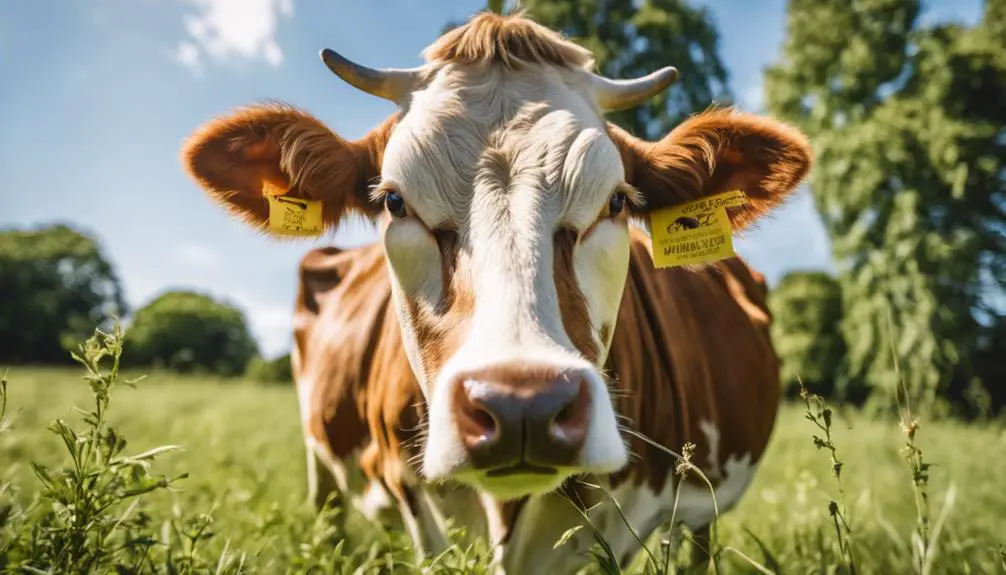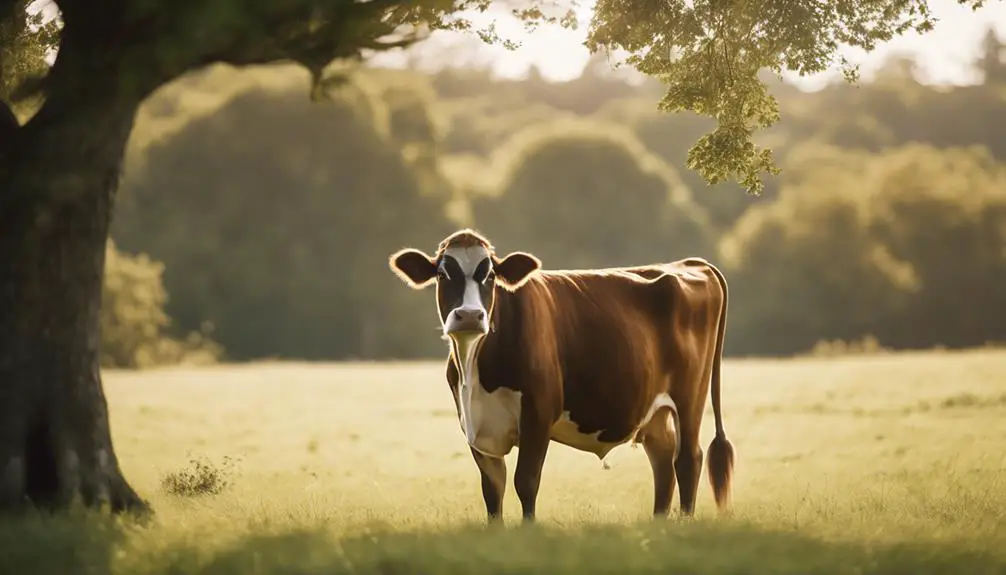You can easily identify a Jersey cow by its unique features. They typically weigh between 800 to 1,200 pounds and have a light brown to nearly black coat, with medium shades being most preferred. Look for their distinctive dark tongue, black nose, and white muzzle—these traits set them apart. Mature Jerseys stand around 46 inches tall at the withers for cows and 50 inches for bulls. Also, their docility and strong adaptability make them excellent dairy performers. Discover more about their history and breeding types, and you'll gain even deeper insights into what makes Jerseys truly special.
Origin and History

Jersey cattle, renowned for their rich milk and butterfat production, trace their origins back to the Island of Jersey in the English Channel, where they've been recognized as a purebred for nearly six centuries. This breed first gained attention in England around 1771, celebrated for its exceptional dairy qualities. Initially dubbed Alderney cattle, the breed was later renamed Jerseys, marking the start of its journey into the dairy industry.
In the 1850s, Jerseys made their way to the United States, sparking a significant export wave to countries like Canada, South Africa, and New Zealand. The breed thrived from the 1860s until World War I, establishing itself as a favorite among dairy farmers globally. This popularity came from the Jersey's ability to produce high-quality milk rich in butterfat, making them a top choice for dairy production.
On the Isle of Jersey, strict import bans have preserved the breed's purity, resulting in fewer than 6,000 Jerseys remaining today, including roughly 4,000 adult milking cows. Understanding this origin and history enriches your appreciation for the Jersey breed and its crucial role in dairy farming.
Physical Characteristics
When you look at a Jersey cow, you'll notice their striking physical traits that make them stand out in the dairy world. Typically weighing between 800 to 1,200 pounds, with an average around 900 pounds, these cows have a refined appearance. Their heads and shoulders exhibit a distinct elegance, complemented by long, straight top lines.
Jersey cows are celebrated for their color variation, which ranges from light brown to nearly black. You'll often find that medium shades are preferred over the extremes. One of the defining physical characteristics of true Jerseys is their dark tongue and switch; they also have a black nose and a white muzzle, which makes identifying this breed easier.
In terms of height, mature Jersey cows average about 46 inches (117 cm) at the withers, while mature bulls are around 50 inches (127 cm) tall. These features not only enhance their beauty but also contribute to their functionality in dairy farming. The combination of size, color, and unique traits makes Jersey cows a remarkable choice for any dairy operation.
Adaptability and Performance

Adaptable by nature, Jersey cows thrive in a variety of climates and geographical settings, which is why you'll find them in herds across the globe, from Denmark to Australia. Their impressive adaptability makes them one of the top dairy breeds, excelling in both intensive grazing programs and diverse agricultural practices. You'll notice Jersey cows are excellent grazers, efficiently converting feed into high-quality milk.
One significant advantage of Jersey cows is their heat tolerance. Unlike larger breeds, they handle warmer climates exceptionally well, maintaining solid performance even in challenging conditions. This trait allows farmers to raise them in regions that may not be suitable for other dairy breeds.
Moreover, Jersey cows stand out in milk production. On average, they produce over 13 times their body weight in milk per lactation, demonstrating remarkable efficiency. Weighing around 900 pounds (approximately 400 kg), they're not just efficient grazers; they also yield milk with superior butterfat content. This combination of adaptability and high performance makes Jersey cows an invaluable asset to dairy operations worldwide.
Breeding Types
If you're exploring the world of Jersey cattle, you'll quickly discover that there are two primary breeding types: the Island Jersey and the American Jersey. Each type has distinct characteristics that cater to different purposes within the dairy industry. The Island Jersey is known for its refinement and aesthetic features, often excelling in show environments. In contrast, American Jersey Cattle are larger and coarser, focusing primarily on milk production.
Here are three key differences between these breeding types:
- Appearance: Island Jerseys are refined and visually appealing, while American Jerseys prioritize productivity over aesthetics.
- Milk Production: American Jerseys have been bred for superior dairy performance, making them ideal milking cows in various climates.
- Adaptability: Both types display remarkable adaptability, thriving in diverse environments, from Denmark to Australia.
Recent trends have blurred the lines between these two types, as milk production capabilities gain importance across the Jersey breed. With enhanced imports, American Jerseys have improved in both production and conformation, further solidifying their role in dairy farming. Understanding these breeding types will help you make informed decisions in the world of Jersey cattle.
Management and Temperament

Managing Jersey cattle requires an understanding of their temperament and behavior. Generally, Jerseys are known for their docile and manageable nature, making them a popular choice in dairy operations. Their calm demeanor allows you to handle them more easily, although you might encounter some nervousness from time to time. Keep in mind that Jersey bulls can be less docile, particularly once they hit eighteen months, so exercise caution around them due to their unpredictable temperament.
Their medium weight—ranging from 800 to 1200 pounds for cows and 1200 to 1800 pounds for bulls—adds to their efficient management in various farming setups. Additionally, Jerseys exhibit strong adaptability to different management practices and climates, which enhances their effectiveness in modern dairy parlors. This adaptability means you can implement various management strategies without drastically affecting their performance.
When selecting Jerseys for breeding, focus on their producing ability and identification traits like a dark tongue and switch rather than color patterns. Overall, understanding the temperament and management needs of Jersey cattle will lead to a more productive and harmonious dairy operation.
Health Benefits and Nutrition
Recognizing the exceptional health benefits and nutritional value of Jersey milk can greatly enhance your dairy operation. This breed is renowned for its superior milk production, offering significant advantages that can boost both your herd's health and your bottom line.
Here are three key health benefits and nutritional highlights of Jersey milk:
- Higher Nutritional Content: Jersey milk contains 18% more protein, 20% more calcium, and 25% more butterfat than milk from other breeds. This makes it a nutrient-dense choice for consumers.
- Improved Herd Health: Jersey cattle have lower rates of mastitis compared to larger breeds like Holsteins. This reduction in udder disorders leads to better milk quality and healthier cows.
- Longevity and Productivity: The adaptability of Jersey cattle to various climates and management practices supports their longevity. This means consistent milk production over time, contributing to efficient herd management.
Frequently Asked Questions
How to Identify Jersey Fabric?
To identify jersey fabric, feel for its smooth texture and check for fine ribs. Notice how it curls at the edges and stretches differently across its width. You'll find it often used in casual clothing.
How to Tell if a Jersey Is Authentic?
To tell if a jersey's authentic, check its registration with recognized organizations. Look for distinctive features like color and markings. Confirm it meets breed standards, as these traits reflect the quality and lineage of the animal.
How Do You Identify a Jersey Cow?
To identify a Jersey cow, look for its medium size, light brown to black coat, refined appearance, black nose, and white muzzle. Remember, these cows are known for their docile nature and high butterfat milk.
How Can You Tell if a Jersey Is Male or Female?
To tell if a Jersey is male or female, look for testicles in males as they grow. Females will develop udders, along with calmer behavior. Size and temperament also give clues about their gender.





Your article helped me a lot, is there any more related content? Thanks! https://www.binance.com/en-IN/register?ref=UM6SMJM3
Can you be more specific about the content of your article? After reading it, I still have some doubts. Hope you can help me.